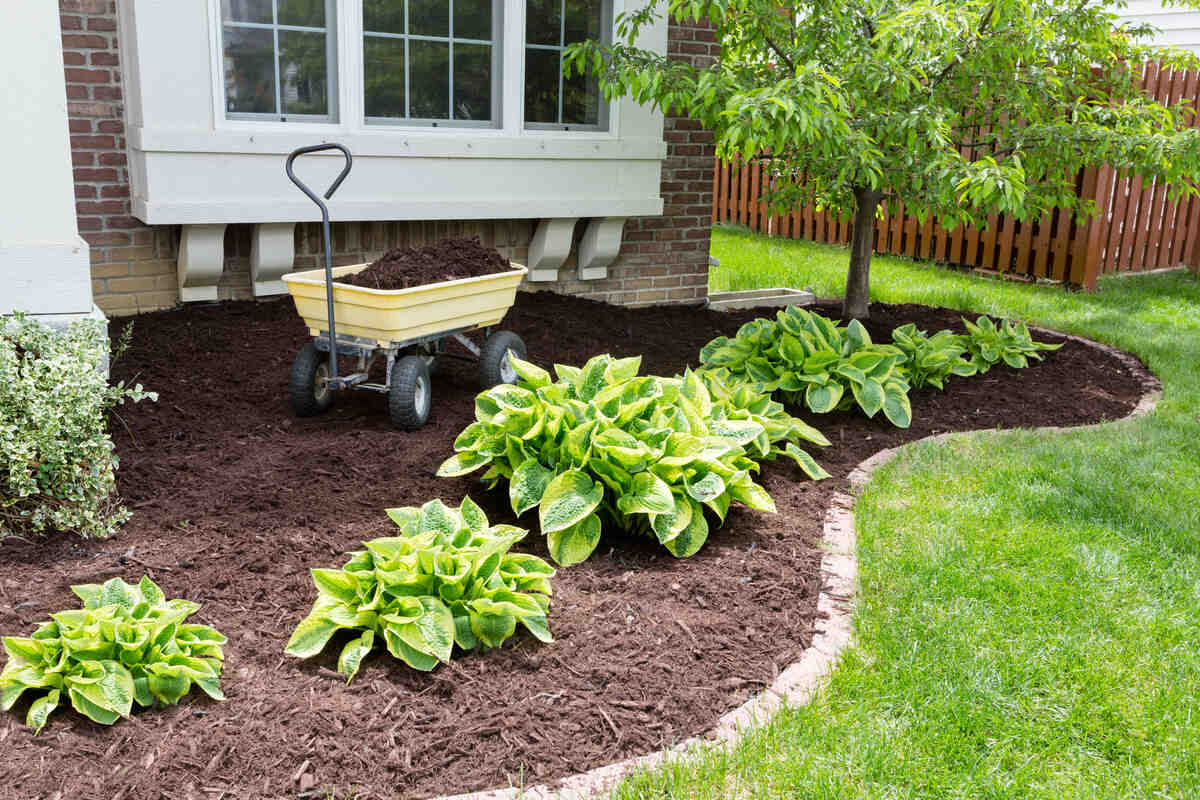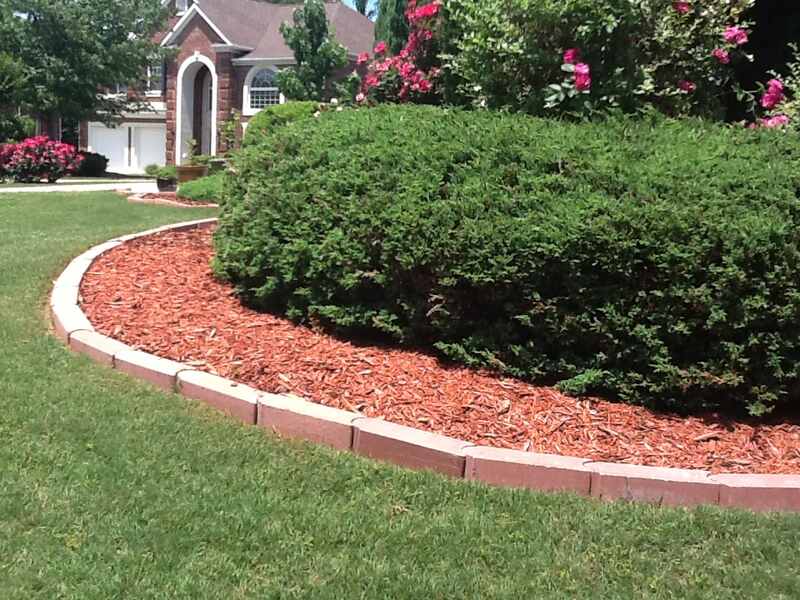
I love the smell of fresh mulch in the spring and the finishing touch it provides for the landscape. I’ll explain how to mulch your yard, from bed preparation to how to apply it correctly.
As a landscape designer, I’ve designed many landscape plans incorporating mulch for homeowners, determined the cubic yards needed for their garden beds, and overseen on-site applications.
| Project Difficulty: Beginner Estimated Time to Complete: 2 to 6 hours, depending on the size of the area. Project Cost: For DIY projects, mulch costs range from $20 to $180 per cubic yard for most types of mulch. If you hire someone, mulch installation costs range from $192 to $402 per cubic yard. |
Tools You’ll Need
Like any DIY project, having the right tools is important for accomplishing the task effectively and efficiently. Here is the equipment you’ll need to spread mulch in your yard:
- Garden rake
- Wheelbarrow
- Large shovel
- Pitchfork
- Edging tool
- Hoe
- Hand weeder
- Weed fork
- Garden hose
My Tip: Wear long sleeves, pants, and workboots while shoveling mulch (old “yard clothes” work best). Moist mulch sticks to everything (especially triple-ground) and can be prickly on your skin. If you have dyed mulch, it may also dye your clothes, especially if it’s wet.
If you’re unsure about delving into the mulch world or lack the strength or time to spread it yourself, contact a landscaping company for assistance.
Step 1: Preparation

Remove Weeds
Whether you’re hand-pulling your weeds or using post-emergent herbicides, getting rid of weeds is key to preparing the area for mulch.
See Related:
Edge Beds
Creating an edge between your garden bed and your lawn keeps your mulch contained. There are two ways you can create an edge:
- An edger (metal half-moon, rotary, or powered edger) creates a defined border along your garden bed.
- Garden edging is available in various styles, colors, and materials (including metal, stone, and plastic).
See Related:
Water the Soil
If you used a post-emergent herbicide to eliminate weeds, don’t water or apply mulch for at least 24 hours. However, after that period, you’ve got the green light to moisten the soil to promote the breakdown of organic materials.
Soaking the soil before mulching allows water to reach the roots directly rather than depending on slower absorption through the mulch.
Apply Pre-Emergent Herbicide
Apply pre-emergent treatments during both spring and fall. The landscape companies I worked for in Pennsylvania preferred granular formulations for straightforward application.
They would either sprinkle it over the soil before adding new mulch or apply it directly on existing mulch during a dry day. Then, they would rake the granules into the topsoil or mulch.
Note: Herbicides that are more resistant to degradation work best when applied on top of the mulch, as they can effectively bind to the organic materials within the mulch.
See Related:
Step 2: Calculate How Much Mulch You’ll Need

Whether you purchase bags of mulch or have it delivered in bulk to your driveway, it’s important to determine the amount you’ll need.
Let’s do some calculations. (If you’d rather not do the math yourself, skip ahead to our mulch calculator below to make this task simple.)
Here are the steps for calculating mulch by volume:
You’ll calculate in cubic feet (if buying bags) or cubic yards (if buying in bulk):
1. Start by calculating the area you want to cover in square feet.
How to calculate the area: For a square or rectangle area, multiply length x width (L x W). For a circle, use 3.14 x the radius squared (𝝅r²).
Ex. Rectangle bed 5 feet wide by 6 feet long = 30 square feet
2. Determine the mulch depth.
| Type of Bed | Mulch Depth |
| Vegetable gardens | 1 to 2 inches |
| Flower beds | 2 to 3 inches |
| Garden beds with trees and shrubs | 2 to 4 inches |
Ex. A 2-inch depth for a flower bed.
3. To calculate the volume, follow these steps:
- Multiply the area (in square feet) by the depth of the mulch (as a fraction of 1 foot; see ex. below). (This gives you cubic feet. If you want cubic yards, you have one more step below.)
- Then divide the result by 27 (since there are 27 cubic feet in a cubic yard).
Ex. Cubic feet: 30 x 1/6 (2 inches/12) = 5 cubic feet
Cubic yards: 5/27 = 0.185 cubic yards
Note: 1 cubic foot of mulch covers 6 square feet at a 2-inch depth. 1 cubic yard of mulch covers 162 square feet at 2 inches deep.
How to convert volume to weight:
If you’re considering using inorganic mulch such as pea gravel, some suppliers will sell it by the ton. (Others might sell it by the cubic yard.) Generally speaking, 1 cubic yard weighs approximately 1.33 tons. So, if you know how many cubic yards you need (volume) but the supplier sells it by weight, here’s how to do the math:
Cubic yards to tons: Cubic yards × 1.33 = tons
Ex. 1 cubic yard x 1.33 = 1.33 tons
Note: This is a general formula that works best for high-density materials like stone, gravel, and topsoil. Don’t use this formula to convert organic mulch, which is less dense, to tons (though organic mulch is almost never sold by weight).
Mulch Calculator
Mulch Calculator
Quick Mulching Tips
DON’T
- ❌ Pile mulch against tree trunks. This can cause bark rot and invite pests.
- ❌ Pile mulch against your house foundation
- ❌ Till carbon-rich mulch (e.g. sawdust) into the soil, it can tie up nitrogen.
DO
- ✓ Remove weeds before applying mulch
- ✓ Keep mulch 2-3 inches away from plant stems and 3-4 inches away from tree trunks
- ✓ Refresh mulch when it starts to decompose, usually annually.
Results for ${selectedMulch.name}
Material Needed:
| Volume (cubic feet): | ${document.getElementById('mc-cubic-feet').textContent} |
| Volume (cubic yards): | ${document.getElementById('mc-cubic-yards').textContent} |
| Weight (tons): | ${document.getElementById('mc-tons').textContent} |
| Bags needed: | ${document.getElementById('mc-bags').textContent} (${document.getElementById('mc-bag-size').textContent} cu ft) |
Work Information:
| Wheelbarrow loads: | ${document.getElementById('mc-wheelbarrow').textContent} |
| Total weight: | ${document.getElementById('mc-total-weight').textContent} lbs |
| Durability: | ${document.getElementById('mc-durability').textContent} |
Estimated Cost:
$${document.getElementById('mc-total-price').textContent}
Quick Mulching Tips
DON'T
- ❌ Pile mulch against tree trunks. This can cause bark rot and invite pests.
- ❌ Pile mulch against your house foundation
- ❌ Till carbon-rich mulch (e.g. sawdust) into the soil, it can tie up nitrogen.
DO
- ✓ Remove weeds before applying mulch
- ✓ Keep mulch 2-3 inches away from plant stems and 3-4 inches away from tree trunks
- ✓ Refresh mulch when it starts to decompose, usually annually.